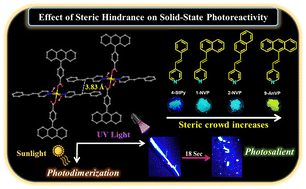This study demonstrates the effect of steric hindrance on the solid-state photoreactivity investigated in four discrete complexes [Cd(9-AnBz)2(4-StPy)2(MeOH)2]·2H2O (1), [Cd2(9-AnBz)4(1-NVP)4]·2MeOH (2), [Cd2(9-AnBz)4(2-NVP)4] (3), and [Cd(9-AnBz)2(9-AnVP)2(MeOH)2] (4), where 9-AnBz = 9-anthracenyl-4′-benzoate, 4-StPy = (E)-styryl-4-pyridine, 1-NVP = (E)-1-naphthalenevinyl-4′-pyridine, 2-NVP = (E)-2-naphthalenevinyl-4′-pyridine, and 9-AnVP = (E)-9-anthracenylvinyl-4′-pyridine. Their structures have been determined by single-crystal XRD diffraction and the stacking of the arene-containing pyridyl-based auxiliary olefin ligands in these complexes has been analysed. The 4-StPy ligands from two neighbouring complexes were found to stack in a head-to-tail fashion, and thus complex 1 was found to be photoreactive when exposed to sunlight. The process of the photodimerization reaction was further observed to exhibit a photosalient effect when investigated under UV light. With a gradual increase in the steric crowd in the arene moieties of the auxiliary ligands, complexes 2–4 were observed to be photo-inert. Pyridyl-based auxiliary ligands of different steric demands resulted in distinct coordination numbers, geometries, structural diversity, and solid-state photo-reactivity. Solid-state photoluminescence for all complexes 1–4 has been investigated.
